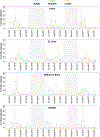Seasonal activity patterns of host-seeking Ixodes scapularis (Acari: Ixodidae) in Minnesota, 2015-2017
- PMID: 37075475
- PMCID: PMC10593201
- DOI: 10.1093/jme/tjad048
Seasonal activity patterns of host-seeking Ixodes scapularis (Acari: Ixodidae) in Minnesota, 2015-2017
Abstract
As the primary vector of Lyme disease spirochetes and several other medically significant pathogens, Ixodes scapularis presents a threat to public health in the United States. The incidence of Lyme disease is growing rapidly in upper midwestern states, particularly Michigan, Minnesota, and Wisconsin. The probability of a tick bite, acarological risk, is affected by the phenology of host-seeking I. scapularis. Phenology has been well-studied in northeastern states, but not in the Upper Midwest. We conducted biweekly drag sampling across 4 woodland sites in Minnesota between April and November from 2015 to 2017. The majority of ticks collected were I. scapularis (82%). Adults were active throughout our entire 8-month collection season, with sporadic activity during the summer, larger peaks in activity observed in April, and less consistent and lower peaks observed in October. Nymphs were most active from May through August, with continuing low-level activity in October, and peak activity most commonly observed in June. The observed nymphal peak corresponded with the typical peak in reported human Lyme disease and anaplasmosis cases. These findings are consistent with previous studies from the Upper Midwest and highlight a risk of human exposure to I. scapularis at least from April through November. This information may aid in communicating the seasonality of acarological risk for those living in Minnesota and other upper midwestern states as well as being relevant to the assessment of the ecoepidemiology of Lyme disease and the modeling of transmission dynamics.
Keywords: Ixodes scapularis; Lyme disease; Minnesota; blacklegged tick; phenology.
Published by Oxford University Press on behalf of Entomological Society of America 2023.
Figures


References
-
- Brinkerhoff RJ, Folsom-O’Keefe CM, Streby HM, Bent SJ, Tsao K, Diuk-Wasser MA. Regional variation in immature Ixodes scapularis parasitism on North American songbirds: implications for transmission of the Lyme pathogen, Borrelia burgdorferi. J Med Entomol. 2011:48:422–428. - PubMed
Publication types
MeSH terms
Grants and funding
LinkOut - more resources
Full Text Sources
Medical
Research Materials
Miscellaneous

